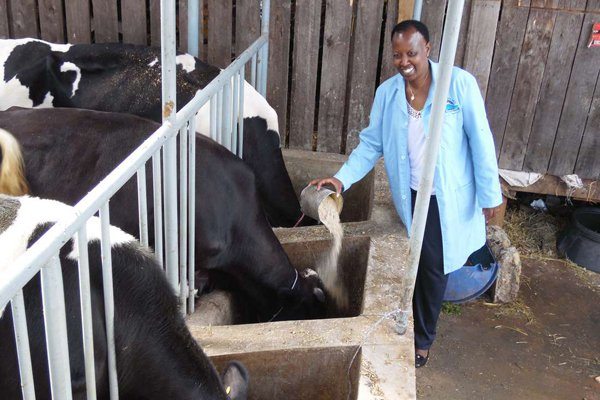BY CAROLINE WAMBUI
Zipporah Ariithi’s farm is located in Kinoru village, Meru County. Known as Briaton Dairy, the farm hosts 22 cows; eight of which are heifers, seven are in-calf, one is a bull, and six are currently being milked, producing between 180 and 200 litres every day.
At the barn, each animal sits in its own cubicle, with cows being milked separated from the heifers, those that are in-calf and the bull.
On top of the animals’ shed is the feeds’ store and other storage structures, enabling her to save on space.
Zipporah has invested in 20 acres of fodder, the bulk of them leased, where she grows maize for ensiling, Boma Rhodes, sunflower and lucerne, among other crops.
“Without feeds you have no dairy farm. I always ensure I store feeds that last me a year. It is the reason why I was never affected by the recent dry spell,” she says. “I feed the cows on Total Mixed Ration consisting of silage, lucerne, hay and dairy meal mixed with molasses. This mode of feeding is one of the best as it combines forages, grains, protein feeds, minerals, vitamins and feed additives into a single feed mix.”
She feeds the animals depending on their production, but twice a day, that is after every milking at 5am and after 6.30pm, with some supplements being offered after 1pm milking to the lactating cows.
“Milk production is all about feeding the animals right, having proper records, maintaining high standards of hygiene, making good managerial decisions and being financially sound,” says Zipporah, who works with a vet when making any decision concerning the animals.
Zipporah traces her rise to the top in small scale dairy farming back to 2014. Back then, she had two cows that were lactating were offering her only 20 litres a day.
A challenge from a friend to turn the farm into a business saw her enroll for training offered by SNV, a Dutch development organisation, where she was trained on feeding, farm management and animal care, among others. After the training, Zipporah bought three more in-calf heifers at Sh120,000 each.
“I wanted a larger herd but my financial resources could not allow me to buy more in-calf heifers. So I also went for animals that had right qualities but were being disposed by farmers for one reason or the other. I bought the animals and improved their body condition through feeding.”
When purchasing such animals, Phillip Oketch, a dairy consultant in Meru, says one should check the condition of the udder, which should be symmetrical in shape, deep and wide with enough capacity to accommodate high production.
“The four quarters should be well-supported to the belly and with teats of appropriate size and length,” he says, warning an extremely pendulous udder is subject to injury.
For the legs, he says that they have to be flexible and open with hooks apart for good mobility and to avoid a lot of friction with the udder while enhancing free movements to feed, water, sleep and wake comfortably.
The cow should also have a wedge, a long lean neck, clean and alert head, a soft pliable skin broad muzzle and a strong straight backline as a good dairy character is the evidence of proper feed conversion efficiency into milk not meat and fat, a factor that highly determines the return to investment on feed.
Oketch notes a farmer will run at a loss if he goes purchasing feeds and fodder for their animals, especially during the dry season, when prices rise.
“During such times, the farmer will be forced to buy fodder which often is of lower quality. If a farmer manages silage well, he can run the farm at a profit as the maximum cost of producing a kilo of silage is Sh6, but a bale of hay goes for Sh300.”
Zipporah’s farm hosts a small biogas plant that enables her save up to Sh15,000 every month on fuel and lighting.
“Dairy farming has great profits that a farmer can plough back comfortably. I use the money I get from dairy to educate my family,” the former book seller says, noting flu is the only challenge to her cows, but she keeps dry sheds to curb it.
She plans to grow her herd to 50 cows and have an average milk production of at least 25 litres per animal, offering in total 1,000 litres per day.
This feature was first published in the Saturday Nation.








